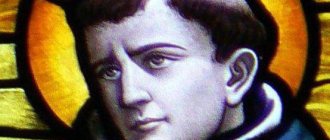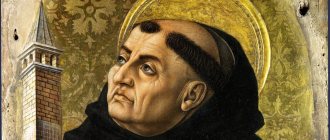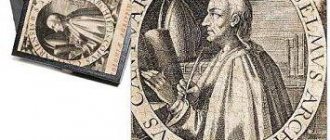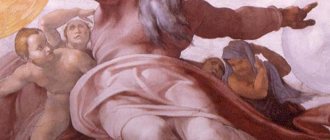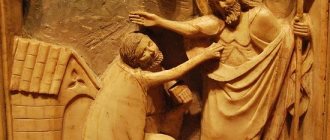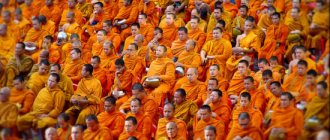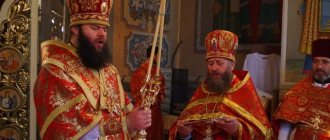Thomas Aquinas is the largest representative of late scholasticism. Born in the Kingdom of Naples near the town of Aquino. He joined the Dominican Order and taught at the University of Paris. The philosophical teaching of Thomas Aquinas covers the entire spectrum of medieval scholasticism - these are problems of the relationship between philosophy and theology, ontological proof of the existence of God, the duality of truth, the problem of universals, the problem of theodicy (interpretation of the nature of evil allowed by God in the world).
Thomas Aquinas on the specifics of philosophy and theology
Thomas Aquinas believed that both theology and philosophy study God and his creation. But while philosophy ascends from divine creations to their creator, theology, on the contrary, proceeds from the recognition of the creator and descends to his creations: “in the philosophical doctrine, which considers creations in themselves and from them ascends to the knowledge of God, at the very beginning they are considered creation and only in the end God; on the contrary, in a creed that considers creatures only in their relation to God, God is considered first and then creatures. And such a sequence is more perfect, because it reveals more similarities with the process of knowing God himself: after all, God, knowing himself, through this contemplates the rest.”
About Aristotle
Albertus Magnus, the teacher of Thomas Aquinas, was the author of the first commentary on Aristotle's Nicomachean Ethics written in Western Europe. It was he who introduced into use Catholic theology the works of Aristotle, previously known in the West mainly as presented by the Arab philosopher Averroes. Albert showed the absence of contradictions between the teachings of Aristotle and Christianity.
Thanks to this, Thomas Aquinas was able to Christianize ancient philosophy, primarily the works of Aristotle: striving for a synthesis of faith and knowledge, he supplemented the doctrinal dogmas and religious and philosophical speculations of Christianity with social, theoretical and scientific reflection based on the logic and metaphysics of Aristotle.
Thomas was not the only theologian who tried to appeal to the works of Aristotle. This was done, for example, by his contemporary Siger of Brabant. However, Seeger's Aristotelianism was considered "Averroist", retaining some of the ideas introduced into the works of Aristotle by his Arab and Jewish translators and interpreters. Thomas’s “Christian Aristotelianism,” based on the “pure” teaching of the ancient Greek philosopher, which does not contradict Christianity, won - and Siger of Brabant was put on trial by the Inquisition and killed for his beliefs.
According to Thomas Aquinas, philosophy should serve theology
Philosophy, Thomas Aquinas insisted, must be subordinate to theology. Its purpose is to clarify the dogmas of theology, to make them more understandable for believers: “This science (theology) can take something from philosophical disciplines, but not because it feels the need for it, but only for the sake of greater clarity of the provisions it teaches. After all, it borrows its principles not from other sciences, but directly from God through revelation. Moreover, it does not follow other sciences as superior to it, but resorts to them as its subordinate servants, just as the theory of architecture resorts to service disciplines or the theory of state resorts to the science of military affairs. And the very fact that it still resorts to them does not stem from its insufficiency or incompleteness, but only from the insufficiency of our ability to understand: the latter is easier to lead from those objects that are open to mediocre reason, the source of other sciences, to those objects that which are above reason and which our science interprets.” Thomas Aquinas owns the famous expression: “philosophy is the handmaiden of theology,” which determined the position of philosophy in Christian Europe for several centuries to come.
Creating infinity
In the 13th century, theologians were plunged into a furious debate about the nature of the universe - whether the Universe always existed or was created at a certain moment. This debate continues today, but Thomas Aquinas was confident that he had found the answer to this question.
He was not only a priest, he was a scholastic philosopher, and Christian doctrine and the teachings of Aristotle served as inexhaustible sources of inspiration for him. Aristotle argued that the universe has always existed and there would never be a moment when it was not here. However, the book of Creation describes the process of God creating the world. So which concept is correct? The scholastic philosophers agreed with Aristotle, but this led them to diverge from official religious doctrine - which was not very encouraged in the Middle Ages. In any case, the ancient philosophers found a flaw in Aristotle's arguments. Is it possible that the great Stagirite was mistaken?
The argument refuting the concept of an eternal Universe sounded something like this: Aristotle argued that the Universe will exist for an infinite number of days and has already existed for the same number of days. In Ancient Greece, infinity was a complex topic: true infinity, which implies the simultaneous existence of an infinite number of things, was considered incomprehensible to the human mind and remained the domain of the gods, and thus it turned out that Aristotle recognized it as impossible.
Aristotle, who died long before Jesus came to earth, knew nothing about the concept of the Holy Trinity. But Thomas Aquinas noted that this does not mean that he would not agree with this idea.
However, infinite time was recognized as possible in the format of “potential infinity”, since days pass one after another. If this is so, Aristotle’s opponents noted, then the number of immortal human souls that have accumulated over an infinite number of times in the Earth’s past would amount to true infinity, which contradicts the arguments of Aristotle himself.
Aquinas destroyed this opposition to Aristotle. God is omnipotent, which means he is completely capable of creating an eternal Universe. He created it at some point in time in the past, as the Bible and other holy books state, but God gave it an infinite past and an infinite future. And therefore, already at the moment of creation, the Universe always existed and there was no time when it did not exist, as Aristotle argued. The logical art of Thomas Aquinas made it possible to recognize both points of view as absolutely correct!
Aristotelianism
Aristotle's philosophy influenced the work of many generations of philosophers. Thomas Aquinas gave a simple explanation in cases where Aristotle's teachings contradicted Christian dogmas: God created Aristotle, so his ideas could not be false. They only seem to contradict the word of God because Aristotle lived long before Christ and therefore was not given the revelation of God.
Thomas Aquinas on the nature of universals
In the debate between nominalists and realists about the nature of universals, Thomas Aquinas took the position of moderate (Aristotelian) realism. According to him, universals exist in three ways: before things, in the consciousness of God, as ideas of future things, as ideal eternal prototypes of existence; in things - as common, coinciding signs of many things, and after things - in human thinking as a result of abstraction, as concepts about them. If we discard the mention of the mind of God, then any modern atheist philosopher can agree with the second and third forms of existence of universals.
Teaching activities
Upon completion of his studies, Thomas was called to Rome, where the famous theologian became an adviser to the Pope. Here he gave lectures to students of the studio. Aquinas was actively involved in teaching, giving lectures on several subjects at once, devoted to different areas of philosophy.
After 10 years living in Rome, Thomas returned to France, where he began to popularize the works of Aristotle, continuing to teach, but now at a French university.
After the Dominican Order founded a university in Naples, Thomas returned there as a master. Aquinas was only able to lecture there for a short time - due to health problems, he had to leave teaching.
More about prominent church figures:
- Life of Simeon the New Theologian
- Metropolitan Michael of Kyiv
- Abba Dorotheus
The problem of truth in the philosophy of Thomas Aquinas
Thomas Aquinas distinguished two sources of knowledge of truth: “from nature” and through divine revelation: “The knowledge of truth is twofold: it is either knowledge through nature, or knowledge through grace. And that knowledge that occurs through grace, in turn, is twofold: the first type of knowledge is exclusively speculative, such as when certain divine secrets are revealed to a certain person; another kind of knowledge is associated with feeling and produces love for God. And the latter is a special property of the gift of wisdom.” Following the ideas of Aristotle, in the Summa Theologiae, Thomas Aquinas defined truth as “the correspondence of the intellect and the thing.”
Thomas Aquinas on the proofs of the existence of God
Thomas Aquinas disagreed with the “ontological” proof of the existence of God previously proposed by Anselm of Canterbury. In contrast, he put forward five arguments in favor of the existence of God, of which the most famous was the so-called “cosmological” argument. Its essence lies in the interpretation of the existence of God as the “first cause” of all things. As the first cause, God creates numerous kinds and kinds of things, endowed with varying degrees of perfection. A special place in creation is occupied by man, who is the unity of the material body and soul as a form of the body.
Fate
Thomas Aquinas, or Thomas (Thomas) Aquinas, was presumably born on January 25, 1225 in the Italian city of Aquino (the territory of modern Lazio), in the Roccasecca castle. Father Landolf Aquinas served as a knight under King Roger II, and Theodora, a Neapolitan mother, raised seven children.
Portrait of Thomas Aquinas
While the eldest sons were mastering military affairs, the parents chose for Thomas the path of Sinibald, brother of Landolf, who served as abbot at the Benedictine monastery of Montecassino. At the age of 5, the boy ended up in a church monastery, in 1239 - at the University of Naples. Here Thomas Aquinas met Aristotle, the Jewish theologian Maimonides, and the Western Arab philosopher Averroes, whose views influenced the theological teachings of the Italian.
At the age of 19, the young philosopher decided to join the Catholic Order of Friars Preachers. Thomas Aquinas's family was against this idea. To avoid Theodora’s interference in the fate of her son, members of the Order tried to hide the thinker in Rome, but on the way he was captured by his brothers.
Thomas Aquinas
The parents, trying to force their son to refuse to join the monastic Order, kept him in captivity for 2 years. They say that once the brothers brought a public woman to the “prison” so that she would break her vow of celibacy. Thomas Aquinas defended himself against her with a hot log.
The young man’s victory over temptation is captured in Diego Velazquez’s portrait “The Temptation of Saint Thomas Aquinas.” The canvas depicts an exhausted Thomas, dressed in monastic robes, being embraced by an angel. Another messenger of heaven stands behind, and a surprised woman looks out from behind his shoulder. On the floor, at the feet of the thinker, lies a charred log.
Painting by Diego Velazquez “The Temptation of Saint Thomas Aquinas”
The philosopher kept his vow of celibacy until his death; Thomas Aquinas preferred personal life in its common meaning to scholasticism. He did not have a wife or children.
Realizing that his efforts were not bringing results, in 1244 Theodora organized Thomas’s escape, first to Naples, then to Rome, where the philosopher met with Johann von Wildeshausen, Master General of the Order, and joined the ranks of the monastic organization.
Johann von Wildeshausen
In 1245, the young man entered the University of Paris, and the theologian Albertus Magnus became his mentor. Due to his heaviness and humility, too strict even for a monk, fellow students teased Thomas Aquinas with the Sicilian Bull. In response to ridicule, Albertus Magnus uttered a prophetic quote:
“You call him a dumb bull, but his ideas will one day roar so loudly that they will deafen the world.”
Following his teacher, 3 years later, Thomas went to Cologne, where he explained the laws of the Old Testament to students. In 1252 he returned to Paris to obtain a master's degree in theology. For his services to teaching, after 4 years the philosopher was offered to become regent of the University of Paris; in 1268, Thomas again took this position.
Thomas Aquinas left an imprint on the history of the Roman Catholic Church: in 1261, Pope Urban IV commissioned the philosopher to compose hymns for the new feast of Corpus Christi. "Pange lingua", "Tantum ergo" and "Panis angelicus" are still performed today.
Thomas Aquinas hears the voice of Jesus Christ
In 1265, the church again turned to Thomas for help: the next Pope, Clement IV, offered the Italian a position as a theologian.
In 1272, after leaving his post as regent of the University of Paris, Thomas Aquinas moved to Naples, where he preached to the people. A year later, the thinker was overtaken by God’s enlightenment. Legend has it that after morning mass in the Dominican monastery of Naples, in the chapel of St. Nicholas, Thomas heard the voice of Christ:
“You described me well, Thomas. What reward do you want for your work?
Thomas replied:
“Nothing but you, Lord.”
Another enlightenment took place in December 1273, when, during a sermon, Thomas Aquinas was struck by a prolonged ecstasy. He refused to continue his largest work, which later became known as the Summa Theologica. After resting, the thinker’s thirst for writing arose again, but he never managed to complete the treatise.
Pope Gregory X announced the convening of the Second Council of Lyons, the main goal of which was the reconciliation of the Roman Catholic and Orthodox churches. Thomas Aquinas was also invited to the meeting. Along the way, while riding a donkey along the Roman Appian Way, a man hit his head on the branch of a fallen tree and became seriously ill.
Tomb of Thomas Aquinas
The philosopher was taken to Montecassino for treatment. Having regained his health, Thomas set off on the road, but fell ill again. He was sheltered in the Abbey of Fossanova. The monks looked after him for several days. Thomas Aquinas died on March 7, 1274 at the table - he was commenting on the Song of Solomon.
50 years later, on July 18, 1323, Pope John XXII proclaimed Thomas Aquinas a saint, and named March 7 in the Roman holiday calendar as the Day of St. Thomas Aquinas. After 1969, the date shifted to January 28. The remains of the philosopher were transferred several times: in January 1369 - to the church of the Jacobin monastery in Toulouse, from 1789 to 1974 they were kept in the Basilica of St. Saturninus of Toulouse, then returned to the church of the Jacobin monastery, where they remain to this day.
The problem of evil in the philosophy of Thomas Aquinas
For all scholastics, and not only for them, the problem of justifying the existence of evil in the world was urgent. If the Christian God is omnipotent and good, why did he allow the existence of evil in the world he created? Thomas Aquinas considered evil as a less perfect good - it is allowed by God so that all stages of perfection are realized in the Universe, “the perfection of the universal good is not damaged.” If all instances of evil were eliminated, the world would lack many good things. Thus, without the killing of animals, the life of lions would be impossible, and without the cruelty of tyrants, the steadfastness of martyrs (Ibid.). At the same time, good is higher than evil, it dominates over evil: “There is no single primary principle of evil in the sense in which there is a single principle of good... everything that exists, to the extent that it exists, is good... evil exists only in good , as its substrate." Thus, evil can arise only “accidentally” (by chance) in the consequences of the single primary good, which is God.
Proceedings
The works of Thomas Aquinas include:
- two extensive treatises in the summa genre, covering a wide range of topics - "Summa Theology" and "Summa against the pagans" ("Summa Philosophy")
- discussions on theological and philosophical issues (“Debatable Questions” and “Questions on Various Topics”)
- comments on: several books of the Bible
- 12 treatises of Aristotle
- "Sentences" of Peter of Lombardy
- treatises of Boethius,
- treatises of Pseudo-Dionysius
- anonymous "Book of Reasons"
“Debatable Questions” and “Commentaries” were largely the fruit of his teaching activities, which included, according to the tradition of that time, debates and reading authoritative texts accompanied by commentaries.
Historical significance of the philosophical teachings of Thomas Aquinas.
The fairly comprehensive philosophical and theological teaching of Thomas Aquinas was one of the highest achievements in the development of scholasticism. For his services to the Catholic Church, expressed in the adaptation of Aristotelian philosophy to Christian theology, he was canonized as a saint at the next Ecumenical Council in 1323. His teaching even in our time acts as the leading direction of Catholic theology, since the official theology of the Vatican is neo-Thomism - a modernized version of the views of F. Aquinas. As for his purely philosophical views, they are of only historical value, like all scholasticism in general.
- < Back
- Forward >
Education
Aquinas had an unusually good memory; he remembered the words of his teachers verbatim. Later he only improved his skills. For example, Thomas compiled a collection of sayings of the church fathers about the Gospel. When the young man worked on this topic, he reviewed many sources.
At the same time, Foma did not take notes, but simply memorized the necessary information. His memory was so tenacious that the philosopher remembered everything he happened to read.
Interesting! The philosopher himself explained this phenomenon by the fact that he worked hard on himself. According to him, memory is subject to the mind, so the necessary information should be arranged in parts in the correct sequence. Then, having remembered one fragment, the mind itself suggests the next one.
The second way to develop a good memory is to be interested in what you are doing. And of course, it is worth reflecting and repeating the acquired knowledge more often. Thomas studied first at the University of Paris and then at the University of Cologne.
In Paris he was one of the best students of Albertus Magnus. Afterwards, Thomas became a teacher of theology and wrote his first philosophical works. Ancient works attracted his mind, although they contradicted generally accepted Catholic truths. So Thomas agreed to the voluntary temptation of knowledge.
Natural Mind
Aristotle had already penetrated under the vaults of monastic cells. The Church was forced to come to terms with this pagan sage, for he collected the best pagan thoughts and embodied them in his works. In addition, Aristotle was referred to by opponents of Catholics - Muslims and Jews. By the way, Byzantine Orthodoxy has already lost its missionary fervor, having closed itself in its own “ivory tower.” Countries that became recipients of the Byzantine tradition inherited an arrogant attitude towards dissidents. But Catholicism sought to convince the infidels that it was right, and it desperately needed secular arguments.
Thomas realized that the debate needed a neutral platform where representatives of different faiths would feel at home. The sphere of rational thinking, where logic and human experience dominate, has become such a platform. European philosophy emerged from the close tutelage of theology in order to become understandable to everyone. Thomas Aquinas destroyed the dualism of thinking of the early Middle Ages, based on the teaching of St. Augustine about two spheres of existence. In such a world, a person belonged to either God or Satan, but did not belong to himself. Accordingly, either divine or devilish will could act in a person. Now the human mind received the right to life, in order to subsequently become the engine of progress and the source of new ideas.
Thomas wrote some of his works for specific disputes with Arabs and Jews that took place in Spain. Let us remember that this country at that time was part of the Islamic world, where sciences, arts and crafts flourished. Christians and Sephardic Jews freely practiced their faith here, engaging in religious polemics among themselves and with learned mullahs. Catholics looked more than modest against the background of educated rabbis and Arab sages. Thomas Aquinas begins to correct this situation.
Editions
Currently, there are numerous editions of the works of Thomas Aquinas, in the original and translations into various languages; Complete works were published several times: “Piana” in 16 volumes. (by decree of Pius V), Rome, 1570; Parma edition in 25 volumes. 1852-1873, reprint. in New York, 1948-1950; Opera Omnia Vives, (in 34 volumes) Paris, 1871-82; “Leonina” (by decree of Leo XIII), Rome, from 1882 (from 1987 - republication of previous volumes); published by Marietti, Turin; edition by R. Bus (Thomae Aquinatis Opera omnia; ut sunt in indice thomistico, Stuttgart-Bad Cannstatt, 1980), also released on CD.
